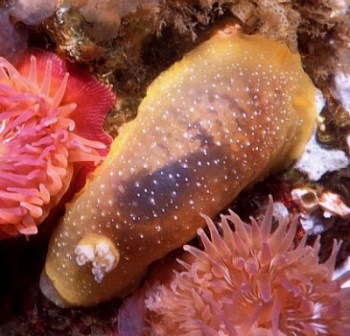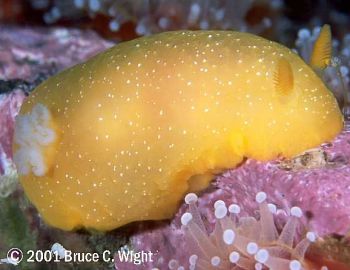

Doriopsilla albopunctata
(Cooper, 1863)
Order: NUDIBRANCHIA
Suborder: DORIDINA
Superfamily: EUDORIDOIDEA
Family: Dendrodorididae
DISTRIBUTION
California, USA to Baja California, Mexico.
PHOTO
UPPER: Channel Ids, California, USA .Photo: Ken Tucker.
LOWER: San Miguel Island [Channel Ids, California] July 2000. Photo: Bruce Wight.
D. albopunctata grows to 60mm in length Its colour varies from yellow, orange to brown and the mantle is ornamented with opaque white spots some of which are present in the centre of conical tubercles. The white spots are small glands. The size and density of the tubercles varies widely between animals in single populations. The rhinophores are orange-yellow to yellow and have about 11-30 lamellae. There are 5-6 bi- or tripinnate gills which are white to pale yellow. The egg ribbon forms a upright spiral attached along one edge. It is yellow, orange or off-white. The larvae are planktotrophic. Doriopsis reticulata Cockerell 1905 and Doriopsis fulva MacFarland, 1905 are considered synonyms of this species.
There are two recently described species which are very similar in shape and colour.
• Doriopsilla gemela Gosliner, Schaefer & Millen, 1999 is similar in colour with small opaque white spots, but its mantle appears to be smooth although it has some minute tubercles. It grows to 40 mm. Its rhinophores are yellow-orange to yellow and they have 7-10 lamellae. There are 5-7 bright orange or yellow bi- to tripinnate gills. The egg ribbon forms a flattened spiral of 3 whorls, and the larvae are lecithotrophic. It differs in having deep yellow or yellow-orange gills whereas D. albopunctata has white or pale yellow gills. There are fewer rhinophore lamellae in D. gemela, and the larger mantle tubercles of D. albopunctata contain glands while the small ones of D. gemela don't. The larval development type and egg ribbons are also quite different.
• Baptodoris mimetica Gosliner, 1991 is also very similarly coloured. D. albopunctata differs in having a relatively soft & fleshy body while B. mimetica is more rigid and the mantle is covered with microscopic caryophyllidia. The gills of B. mimetica are held more erect, and unlike species of Dendrodoris and Doriopsilla, Baptodoris mimetica has a head and oral tents. There are of course many anatomical differences.
Despite these many apparent differences, it is not always easy to distinguish these three species from photographs.
References:
• Gosliner, T.M. (1991) Four new species and a new genus of opisthobranch gastropods from the Pacific coast of North America. The Veliger, 34(3): 272-290.
• Gosliner, T. M., Maria C. Schaefer, & Sandra V. Millen. (1999) A new species of Doriopsilla (Nudibranchia: Dendrodorididae) from the Pacific Coast of North America, including a comparison with Doriopsilla albopunctata (Cooper, 1863). The Veliger, 42(3): 201-210.
Rudman, W.B., 2001 (August 5) Doriopsilla albopunctata (Cooper, 1863). [In] Sea Slug Forum. Australian Museum, Sydney. Available from http://www.seaslugforum.net/factsheet/dorialbo
Related messages
-
Flatworm mimic? of Doriopsilla albopunctata
From: Bruce Wight, February 9, 2005 -
Doriopsilla albopunctata from California
From: Bruce Wight, August 10, 2004 -
Doriopsilla albopunctata egg ribbon
From: Sean Kearney, September 4, 2003 -
Mating Doriopsilla albopunctata
From: Bruce Wight , August 3, 2003 -
Doriopsilla albopunctata at San Nicolas Island
From: Chris Grossman, July 30, 2003 -
Doriopsilla albopunctata? from California
From: Ken Tucker, August 8, 2001 -
Doriopsilla albopunctata from California
From: Bruce Wight, August 8, 2001
